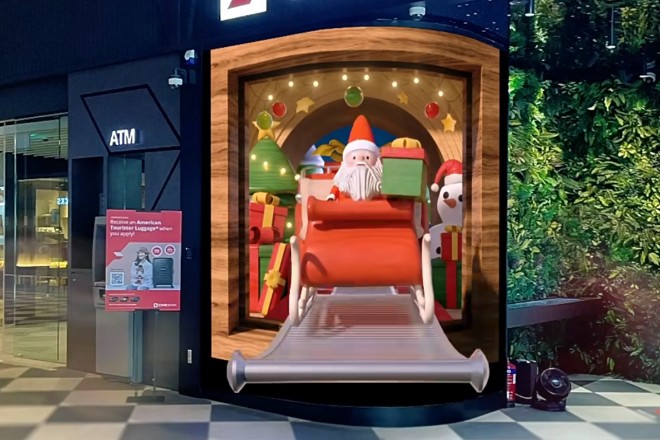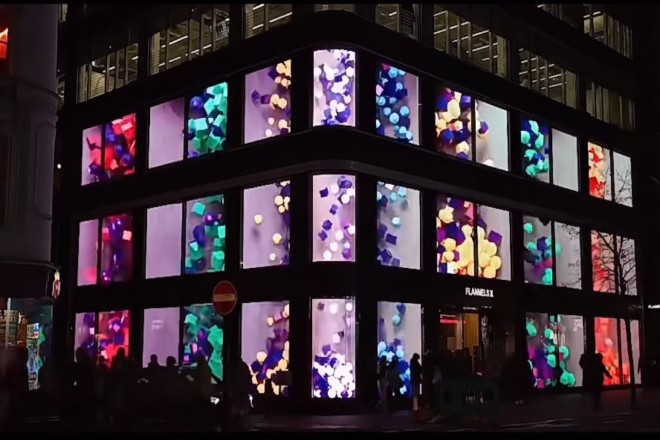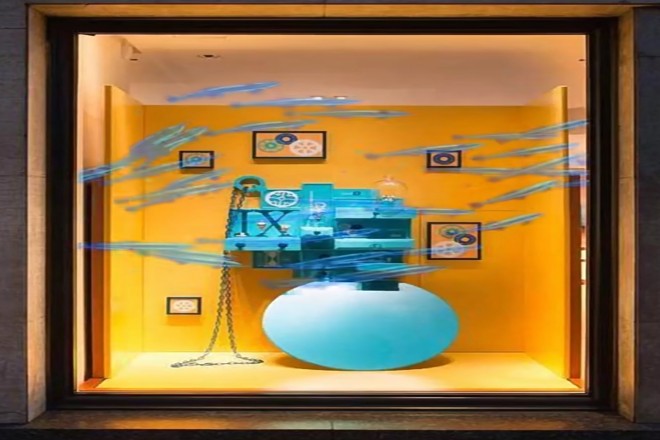序章

In today’s rapidly changing retail industry, store windows are the primary front to attract customers. Traditional display methods can no longer meet the diversified needs of modern consumers.
の出現 3D LEDディスプレイ technology has brought unprecedented changes to store windows with its unique three-dimensional effects, high definition, and dynamic display capabilities.
1. Analyze the feasibility of installing 3D LED display screens in store windows

1). Hardware adaptability considerations
When considering installing 3D LED display screens for store windows, the first thing we need to pay attention to is whether the conditions of the window itself match it.
- Size and Space:
The size of the window should be able to accommodate the selected 3D LED display, while ensuring that there is enough space for installation and maintenance.
This means that before deciding to buy, we need to carefully measure the size of the window and make sure the specifications of the display are compatible with it.
- Structural Strength:
The structure of the window must be strong enough to support the weight of the display. If the structure of the window is not stable enough, additional reinforcement measures may be required to ensure the safe use of the display.
The operation of the 3D LED display requires stable power support. You need to check the store’s power facilities to ensure that they can meet the power needs of the display. If the power is insufficient, you may need to consider upgrading the power facilities or taking other solutions.
2). Cost and Benefit Analysis
Next, we need to evaluate the feasibility of this project from a cost-effectiveness perspective.
- Initial Investment:
The purchase and installation costs of 3D LED displays are relatively high, which is the main cost to consider. When choosing a display, you need to weigh price, performance, and quality to find the option that best suits your store’s needs.
- Operating Costs:
In addition to the purchase and installation costs, you also need to consider the daily operating costs of the display, such as power consumption, maintenance costs, etc. These costs will accumulate over time, so they need to be fully considered in the budget.
- Commercial Return:
From a commercial perspective, 3D LED displays can enhance the store’s attractiveness and brand image, which may lead to higher sales and customer traffic. However, this return is not immediate but requires a certain amount of time and effort to cultivate.
Therefore, you need to conduct a long-term evaluation of the return on investment to ensure the sustainability of the project.
3). Technical Integration and Compatibility
Finally, you also need to consider the integration of the 3D LED display with the store’s existing systems.
- Content Playback:
The display needs to be able to play high-quality video and image content to show its 3D effect. We need to ensure that the display supports common video formats and signal input methods so that it is compatible with existing playback devices or systems.
- 制御システム:
The control system of the 3D LED display needs to be stable, reliable, and easy to operate and maintain. When choosing a control system, we need to consider its compatibility with the display, functionality, and ease of use.
- System Integration:
If the store already has other information systems or advertising playback systems, we need to consider how to integrate these systems with the 3D LED display. This may involve technical issues such as data synchronization and interface docking, which require professional technical support to solve.
In summary, the feasibility of using 3D LED display screens in store windows needs to be comprehensively considered from multiple aspects, such as hardware adaptability, cost-effectiveness, and technical integration.
Only when the hardware conditions are met, the cost-effectiveness is reasonable, and the technical integration is feasible can you draw a positive conclusion and start to implement this project.
2. What are the impacts of 3D LED display screens on store windows?
1). Impact on customer experience:
Imagine that when you are walking in a busy commercial district, you are suddenly attracted by the window of a store.
You find that the goods displayed in that window seem to jump out of the screen and have a silent conversation with you. This unprecedented experience is the magic that 3D LED display screens bring to store windows.
The high definition and three-dimensional effect of 3D LED display screens make the product display vivid and real. Whether it is the elegant texture of fashion clothing or the exquisite details of electronic products, they can be perfectly presented.
Customers can have an intuitive and comprehensive understanding of the products without entering the store. This immersive experience not only enhances the visual enjoyment of customers but also stimulates their shopping interest. They become curious and want to explore these products further, and even have the urge to buy.
2). Impact on brand image:
In a highly competitive business environment, the importance of brand image is self-evident. A 3D LED display is a powerful assistant in shaping brand image and enhancing brand awareness.
Imagine that in the window of a brand store, 3D LED display is showing the brand’s latest series. The cool visual effects and smooth, dynamic pictures all highlight the brand’s sense of technology and innovative spirit. This unique display method allows customers to have a deeper impression of the brand while appreciating the goods.
They begin to think that this is a brand that pursues innovation and pays attention to quality, which is worthy of their trust and choice.
More importantly, the visual effects and interactivity of 3D LED displays can attract more customers’ attention and interest. They will share what they see and feel on social media, thereby further spreading the brand image and enhancing the brand’s popularity and reputation.
3). Impact on sales strategy:
For merchants, the formulation of sales strategy is crucial. And 3D LED display provides them with a new precision marketing strategy.
You need to collect and analyze information such as customers’ shopping behavior, preferences and needs, and then customize personalized display content and marketing strategies.
For example, when a customer shows a strong interest in a certain product, you can use the 3D LED display to display the detailed information, promotional activities, etc. of the product, so as to attract customers to learn more and buy.
In addition, the 3D LED display can also realize remote control and real-time update of display content. This means that merchants can flexibly adjust the display strategy according to different time periods, holidays, or promotional activities.
The implementation of this precision marketing strategy not only helps to increase sales and profits but also enhances customers’ shopping experience and satisfaction. Because customers feel the merchant’s care and concern, they are more willing to choose this store for shopping.
3. Challenges and coping strategies when installing 3D LED displays

Technical problem 1: heat dissipation
In the application of 3D LED displays in store windows, heat dissipation becomes an important technical challenge because it needs to run for a long time and is in a relatively closed environment.
Because high temperature can cause a series of problems such as reduced reliability, unstable performance, and shortened service life of LED displays.
1.1). Coping strategies:
- 効率的な放熱技術を採用:
Such as fan heat dissipation, aluminum heat dissipation fins, air fluid mechanics design, surface radiation heat dissipation treatment, etc. These technologies can effectively reduce the temperature of electronic components inside the display and ensure its stable operation.
- 構造設計を最適化:
In the structural design of the display screen, fully consider the heat dissipation needs, ensure that the heat dissipation channel is unobstructed, and improve the heat dissipation efficiency.
- Select high-quality components:
Select high-temperature resistant and stable components to reduce the failure rate caused by high temperature.
Technical Problem 2: Stability
Stability is a key issue that must be solved in the application of 3D LED display screens in store windows. Since the display screen needs to run for a long time and is often affected by factors such as environmental changes and human interference, it must be ensured to have high stability.
2.1). Response strategy:
- Strict quality control:
In the production process of the display screen, the quality of each link must be strictly controlled to ensure that each component meets the standard.
- Strengthen environmental adaptability:
Improve the adaptability of the display screen to environmental factors such as temperature, humidity, air pressure, dust, etc., to ensure that it can operate stably in various environments.
- アフターサービスの向上:
Provide perfect after-sales service and technical support and promptly solve problems encountered by customers during use.
Technical Problem 3: How to produce high-quality 3D display content to meet the needs of different stores.
3.1). Response strategies:
- Understand store needs:
Before making 3D display content, fully understand the store’s needs and target audience and ensure that the display content is in line with the store’s brand image and marketing strategy.
- Use professional software:
Professional 3D modeling and animation software, such as Maya, 3D Max, etc., can be used to produce high-quality 3D models and animation effects.
- Optimize content design:
According to the actual situation and display needs of the store, optimize the content design to ensure that the display content is attractive, vivid and interactive.
- Update content regularly:
According to the store’s promotional activities, new product releases, etc., regularly update the display content to keep it fresh and attractive.
結論
In summary, the application of 3D LED display screens in store windows not only enhances the customer’s visual experience but also shapes the brand image and promotes sales growth.
However, merchants also need to face technical challenges, content innovation, and maintenance management in the application process.
Therefore, merchants should keep up with technological trends and strengthen technological innovation and talent training to adapt to market changes better.
最後に、LEDディスプレイスクリーンについてさらに詳しく知りたい場合は、 ご連絡ください。
